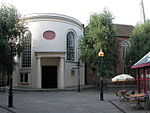New Road, Worcester
1983 Cricket World Cup stadiums1999 Cricket World Cup stadiumsCricket grounds in WorcestershireRoads in WorcestershireSport in Worcester, England ... and 3 more
Sports venues completed in 1896Transport in Worcester, EnglandUse British English from April 2017

New Road is a cricket ground in the English city of Worcester. It has been the home ground of Worcestershire County Cricket Club since 1896. Since October 2017 the ground has been known for sponsorship purposes as Blackfinch New Road following a five-year sponsorship arrangement with Blackfinch Investments.
Excerpt from the Wikipedia article New Road, Worcester (License: CC BY-SA 3.0, Authors, Images).New Road, Worcester
New Road, Worcester, England
Geographical coordinates (GPS) Address Nearby Places Show on map
Geographical coordinates (GPS)
| Latitude | Longitude |
|---|---|
| N 52.189225 ° | E -2.226925 ° |
Address
Worcestershire County Cricket Club
New Road
WR2 4QH Worcester, England
England, United Kingdom
Open on Google Maps








